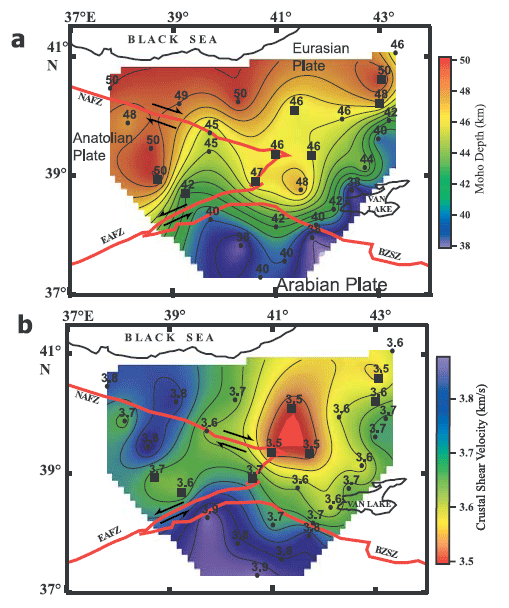Home |
Publications
Zor, E., Sandvol, E., Gurbuz, C., Turkelli, N., Seber, D.,
and Barazangi, M.
The crustal structure of the East Anatolian plateau (Turkey) from receiver
functions
Geophysical Research Letters, 30(24), 2003.
Abstract
The crustal structure of the Anatolian plateau
in Eastern Turkey is investigated using receiver functions obtained from the teleseismic
recordings of a 29 broadband PASSCAL temporary network, i.e., the Eastern Turkey
Seismic Experiment [ETSE]. The S-wave velocity structure was estimated from the
stacked receiver functions by performing a 6-plane layered grid search scheme
in order to model the first order features in the receiver functions with minimum
trade-off. We found no significant crustal root beneath the western portion of
the network, but there is some evidence of crustal thickening in the northern
portion of the network. We found an average crustal thickness of 45 km and an
average crustal shear velocity of 3.7 km/s for the entire eastern Anatolian plateau.
Within the Anatolian plateau we found evidence of a prominent low velocity zone
where the crust thickness is approximately 46 km. These results suggests that
the 2 km high topography across the Anatolian plateau is dynamically supported
because most of the plateau appears to be isostatically under-compensated. Also,
there appears to be a region of thin crust at the easternmost edge of the Anatolian
plateau that may be a relic from the accretion of island arcs to the Eurasian
plate.
Copyright Statement
An edited version of this paper was published by AGU. © 2003 American
Geophysical Union.
Link
to AGU
Key Figures and Captions
Figure 1. Maps showing (a) the Moho depth variation in km
(contour interval is 1 km) and (b) the average crustal shear velocity in km/s
(contour interval is 0.04 km/s) for each station. Black squares indicate stations
which may have a low velocity layer. Red lines indicate the three plate boundaries.

Home
| Publications

